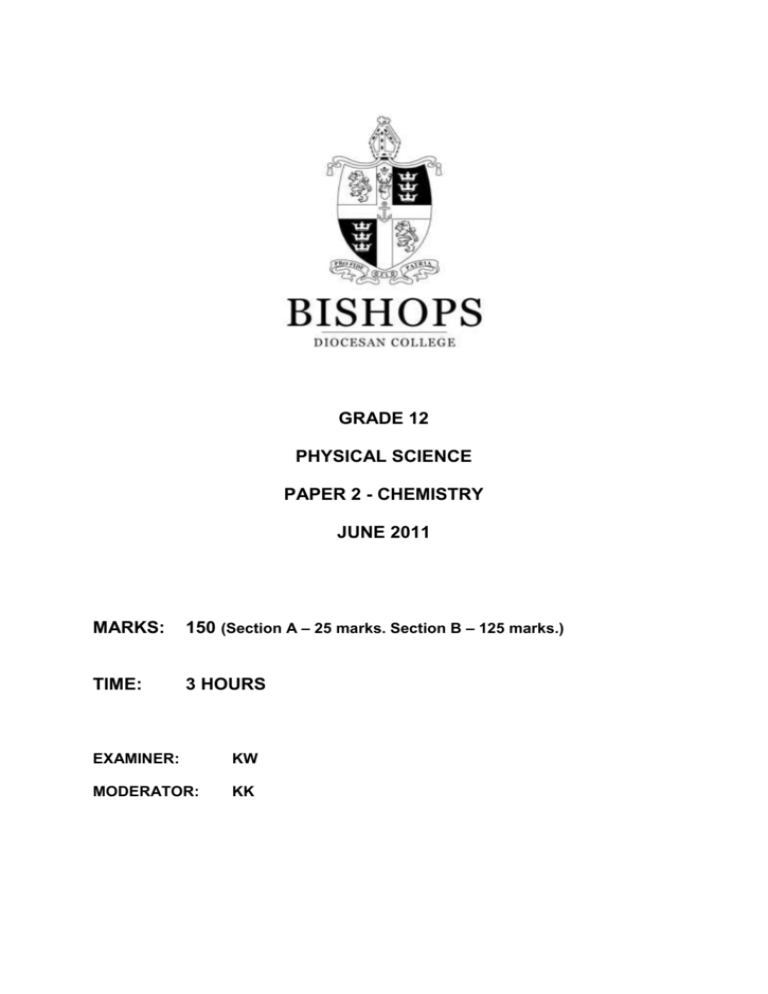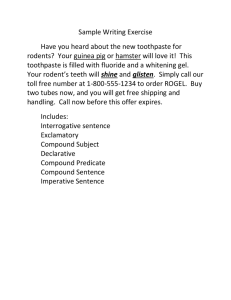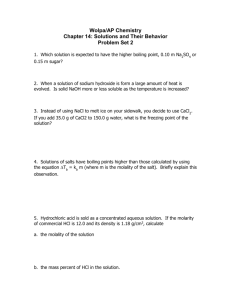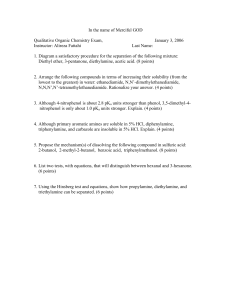2.10 The reaction represented by the equation below
advertisement

GRADE 12 PHYSICAL SCIENCE PAPER 2 - CHEMISTRY JUNE 2011 MARKS: 150 (Section A – 25 marks. Section B – 125 marks.) TIME: 3 HOURS EXAMINER: KW MODERATOR: KK G12Jn11PII General Instructions: 1. Answer ALL the questions. 2. Section A: Follow the instructions below. 3 Section B: (Instructions on page 6.) 4. Refer to the attached data booklet where necessary. Requirements: Pocket calculator Ruler, pencil, pen SECTION A INSTRUCTIONS 1. Answer questions 1-2 on the printed ANSWER SHEET enclosed in your question paper. DETACH this answer sheet and hand it in as the first page of your answers. 2. Do not make any other marks on your answer sheet. Any calculations or writing that may be necessary when answering multiple-choice questions 2.1 to 2.10 should be done on blank / scrap paper. 3. Four possible answers, indicated by A, B, C and D are supplied with each question in Q2. Choose only that answer which in your opinion is the correct or best one and mark the appropriate block on your answer sheet with a cross (X). If more than one block is marked, no marks will be awarded for that answer. EXAMPLE QUESTION: The symbol for the SI unit of time is ... A. B. C. D. t h s m ANSWER: A B C D Page - 2 - of 11 G12Jn11PII SECTION A – ANSWER ON THE ANSWER SHEET PROVIDED QUESTION 1: ONE-WORD ITEMS Give ONE word/term for each of the following descriptions. Write only the word/term next to the question number (1.1 – 1.5) on the attached ANSWER SHEET. 1.1 A substance which will increase the rate of successful collisions in a reaction. 1.2 A reaction which results in a lowering of the internal energy of the reacting substances. 1.3 The reaction condition which, if changed, will cause a change in the equilibrium constant for that reaction. 1.4 The general term for a substance that is oxidised in a redox reaction. 1.5 The part of an organic molecule which can be used to identify a homologous series of compounds. 5 x (1) = [5] QUESTION 2: MULTIPLE-CHOICE QUESTIONS 2.1 Which of the following would have the shortest bond length between carbon atoms? A. CH3CH3 C. CHCH D. CH3CH2OH The graph below represents the relationship between potential energy and course of reaction for a certain chemical reaction. Potential energy (kJ) 2.2 B. CH2CH2 5 4 3 2 1 0 Course of reaction The enthalpy change for the reverse reaction is … A +1 kJ. B +2 kJ. C +3 kJ. D +4 kJ. Page - 3 - of 11 G12Jn11PII 2.3 2.4 When two oxygen atoms combine to form a molecule of oxygen, chemical bonds are _____. A. broken and energy is absorbed. B. broken and energy is released. C. formed and energy is absorbed. D. formed and energy is released. In which of the following compounds does chlorine have its highest oxidation number? A. 2.5 2.6 KClO3 B. NaClO C. Cl2 D. CCl4 Which of the following reactions is a redox reaction? A. NaOH + HCl NaCl + H2O B. AgNO3 + NaI AgI + NaNO3 C. H2SO4 + CaO CaSO4 + H2O D. 2Na + 2H2O 2NaOH + H2 Which of the following statements is most correct with respect to the reaction given? 5FeCl2 + KMnO4 + 4H2SO4 MnCl2 + Fe2(SO4)3 + MnSO4 + 4H2O 2.7 A. Manganese is oxidised. B. Iron (II) is the reducing agent. C. Permanganate ions donate electrons. D. Iron (II) is reduced to Iron (III). The following hypothetical standard electrode potentials are given: P+ + e- ⇌ P -1.8 V Q2+ + 2e- ⇌ Q -0.3 V + 2+ If the P /P and Q /Q redox couples were combined into an electrochemical cell which of the following correctly show the reaction that would take place spontaneously? A. B. C. D. Q2+ Q2+ 2Q2+ 2Q + + + + 2P 2P+ P P+ Q Q 2Q 2Q2+ + + + + Page - 4 - of 11 2P+ 2P P+ P G12Jn11PII 2.8 A compound was shaken up with a solution of bromine. The bromine did not lose its colour rapidly. The compound could have been: A. 2.9 C5H10 B. C6H14 C. CH2CH2 D. methylpropene A sample of calcium carbonate was combined with an excess of hydrochloric acid and is allowed to react until completion. The following chemical equation describes the reaction which takes place. CaCO3 (s) + HCl(aq) CaO(s) + CO2 (g) + H2O(l) Which of the following graphs best represents the reaction rate? A. 2.10 B. C. D. The reaction represented by the equation below reaches equilibrium. 2 2 Cu(H2O) 6 (aq) + 4Cℓ (aq) ⇌ CuCℓ 4 (aq) + 6H2O(ℓ) blue green ∆H > 0 Which of the following changes would result in a green solution? A. Adding water to the solution B. Cooling the solution C. Adding concentrated hydrochloric acid D. Increasing the pressure on the system 10x(2) = [20] SECTION B 1. Answer this section neatly on the lined paper provided. START EACH QUESTION ON A NEW PAGE 2. In ALL calculations a logical layout must be used - using the formulae and substitutions where applicable. 3. Round off your answers to give a sensible degree of accuracy. Page - 5 - of 11 G12Jn11PII QUESTION 3 – ENERGY AND BONDING Some common bond energies are given in the table below. 3.1 Define bond energy. 3.2 Why are bond energies always listed as positive values? (2) 3.3 Explain why some reactions are endothermic by referring to bond breaking and bond forming. (2) 3.4 (2) All hydrocarbons undergo combustion. The combustion reaction for methanol is given below: Bond H-H C-H O–H Energy (kJmol-1) 436 414 460 C-C 347 C-O C=O O=O NN 360 799 499 946 2CH3OH + 3O2 2CO2 + 4H2O (ΔH = - 627,5 kJ.mol-1 of CH3OH) 3.5 3.4.1 Calculate the enthalpy change for the reaction as shown. (2) 3.4.2 Perform a calculation using bond energies from the table above to show that your answer to question 3.4.1 is correct. (4) 3.4.3 Under certain conditions the reaction above will produce carbon monoxide and not carbon dioxide. What conditions would be required? (1) Nitrogen gas can react with oxygen gas to form oxides of nitrogen as shown below: N2(g) + 2O2(g) 2NO2(g) 3.6 3.7 H = 33,1 kJ 3.5.1 Use the bond energy information given in the table to explain why this reaction only takes place under extreme conditions like those produced in the combustion chamber of a car engine. (2) 3.5.2 What feature of the bonding in the N2 molecule is responsible for the necessity of extreme conditions to initiate this reaction. (1) State which one of the bonds listed in the bond energy table given on the previous page you would expect to be the longest? (1) Explain your choice in question 3.6 by referring to values given in the bond energy table. (2) 3.8 Explain why fuels like methanol only ignite in oxygen if a spark or flame is provided but, once they begin burning, they continue to burn until no more fuel is left. (In your answer refer to; collisions, activation energy and heat of reaction.) (3) 3.9 Octane (C8H16) is another example of such a compound which reacts with oxygen as follows: 2C8H18 + 25O2 16CO2 + 18H2O Briefly discuss the sustainability of using carbon based fuels like these to provide for our energy needs in South Africa. In your answer also suggest at least one alternative fuel. (2) [24] Page - 6 - of 11 G12Jn11PII QUESTION 4 – Reaction Rates A group of learners use the reaction between hydrochloric acid and magnesium powder to investigate one of the factors that influence the rate of a chemical reaction. The reaction that takes place is: Mg(s) + 2HCl(aq) MgCl2(aq) + H2(g) The learners conduct the experiment in a corked conical flask and bubble the gas produced into an inverted measuring cylinder. The method followed by the learners is as follows: Method – Experiment 1 1. Place a spatula of magnesium powder in a conical flask and add 50 cm3 HCl(aq) of known concentration. 2. Simultaneously start the stopwatch and close the flask with the rubber stopper containing the delivery tube. 3. Measure the volume of the H2(g) formed in time intervals of 20 seconds. Method – Experiment 2 Repeat steps 1 to 3 above, but use only 25 cm3 of the same HCl(aq) diluted to 50 cm3 with distilled water. 4.1 In which experiment do you expect the gas to be produced at a faster rate? (1) 4.2 Give a reason for your answer to question 4.1. (1) 4.3 Write down an investigative question for this experiment. (1) 4.4 Write down a hypothesis for this experiment. (1) 4.5 Why should the learners ensure that equal amounts of magnesium powder 4.6 4.7 are used in each experiment? (1) State whether the learners method of controlling the amount of powder used is suitable. Write only “Suitable” or “Not suitable”. (1) Give an improvement which could be made to ensure the amount of magnesium powder is more accurately controlled or write; “No improvement possible.” (1) Identify another important control variable which the learners have not taken into consideration. (2) 4.9 Identify the dependent variable in this investigation. (1) 4.10 The experiments were designed with an excess of HCl(aq). Give a reason why the excess amount of HCl(aq) is necessary. (1) 4.8 Page - 7 - of 11 G12Jn11PII After completing the investigation, the learners represent the results obtained during each experiment on the graph below: Graph of volume of hydrogen gas versus time. Y Volume of hydrogen gas (cm3) 70 A 60 50 B 40 30 X 20 10 0 0 20 40 60 80 100 120 140 160 Time (s) 4.11 Explain the relationship between the volume of H2(g) produced and the progress of the reaction by referring to collisions between reacting particles in the flask. (3) 4.12 Which graph A or B represents experiment 1? (1) 4.13 Explain your choice in question 4.12 by referring to a feature of the curves. (1) 4.14 Give a reason why the final volume of gas produced is the same in both experiments. (1) 4.15 State the significance of the line X – Y with respect to the rate of reaction A. (2) 4.16 Use the points X and Y to calculate the relevant rate of reaction B. (2) 4.17 What conclusion can the learners draw from the results obtained? (1) [22] Page - 8 - of 11 G12Jn11PII QUESTION 5 - Equilibria 5.1 State le Chatelier’s Principle. 5.2 Nitrogen reacts with oxygen and, when kept in a closed container at 250 oC, the equilibrium below was set up. (2) N2(g) + O2(g) ⇌ 2NO(g) ΔH>0 If changes were made to the system in equilibrium. Choose from the words; INCREASE, DECREASE or NO CHANGE, to indicate what would occur as a result of each change: Change in number of moles of NO(g) 5.2.1 5.2.3 pressure decrease nitrogen added (4) Value of Kc 5.2.2 5.2.4 5.3 Explain your reasoning in determining your answer to question 5.2.3. (2) 5.4 Explain your reasoning in determining your answer to question 5.2.4 (2) 5.5 The graph below indicates the number of moles of each substance as the reaction proceeded. O2 moles N2 NO 0 5.6 10 20 time (min) 5.5.1 What change would have taken place at 10 minutes? (2) 5.5.2 Explain your answer to question 5.5.1. (3) Explain, in terms of rates of reaction, why no equilibrium shift happens when a catalyst is added to the reaction mixture. (3) N2(g) + O2(g) ⇌ 2NO(g) 5.7 2 mol of N2(g) and an unknown amount (X mol) of O2(g) were enclosed in a 1,5 dm3 sealed flask at 298K and allowed to reach equilibrium. After analysis it is found that the concentration of NO(g) is 0,8 mol.dm-3. The equilibrium constant for this reaction is known to be 0,11 at this temperature. 5.7.1 Write an expression for Kc for this reaction. (2) 5.7.2 Calculate X, the original amount of oxygen in the flask. (7) [27] Page - 9 - of 11 G12Jn11PII QUESTION 6 – Electrochemistry South Africa produces large amounts of aluminium despite the fact that no bauxite ore is mined here. The reason is that we have cheap electricity, which makes it worthwhile importing the ore from as far afield as Australia. Many industrialists query the wisdom of this decision in light of recent power shortages. The long-term sustainability of the industry is now also in doubt as huge electricity price increases are planned. The overall ionic reaction for the process can be written as: 4Al3+(l) + 3C(s) + 6O2-(l) 4Al (l)+ 3CO2 (g) Bauxite (Al2O3) is the ore used. It is dissolved in molten cryolite at high temperature and electrolysed using graphite electrodes. There are a number of features of the process that raise environmental and economic concerns of the effects of this process on society: The mixture is electrolysed at 900oC. The electrolysis requires a large electric current of around 100 000 A to be maintained 24 hrs a day. The process produces large quantities of red mud slurry which is alkaline and must be disposed of. 6.1 Name the element that is oxidised in the overall reaction. (1) 6.2 Write the reduction half-reaction for the cell. (2) 6.3 State one environmental and one economic concern that would be associated with the large scale production of Aluminium in South Africa by referring to information supplied in the question. (2) What features of South African electricity production make this process particularly damaging to the environment? Give a reason for your answer. (2) 6.4 Two half-cells, Li/Li+ and Mg/Mg2+, are used in a lithium ion laptop battery. 6.5 What are the standard conditions for temperature and concentration under which electrode potentials are defined? (2) 6.6 Define an anode? (2) 6.7 What is meant by the term “oxidizing agent”? (2) 6.8 Identify the oxidizing agent in the Lithium/Magnesium cell. (2) 6.9 Write down the oxidation half-reaction. (2) 6.10 Now write a balanced ionic equation for the cell reaction. (3) 6.11 Which electrode would accept electrons from the external circuit? Write either “Mg” or “Li”. (1) 6.12 Calculate the emf of the cell under standard conditions. (3) [24] Page - 10 - of 11 G12Jn11PII QUESTION 7 – Organic Chemistry Alkenes can undergo the following conversions under the correct conditions. H H C C C C C H H H H H H H H H2(g) + H Compound A H H H H H C C C C C H H H H H H Compound B Acid Catalyst H H H H H H C C C C C H H O H H H H Compound C 7.1 Name the alkene in this reaction. (2) 7.2 Define the term “Isomer”. (2) 7.3 Draw the full structural formula and name a branched isomer of this alkene. (4) 7.4 Draw the full structural formula of the compound formed when this branched isomer reacts with hydrogen bromide. (2) 7.5 What do you understand by the term hydrocarbon? (2) 7.6 Name Compound C. (2) 7.7 Which of the three compounds shown would have the highest boiling point? Explain your answer by referring to the functional group in the compound. (3) 7.8 Explain a simple laboratory test you could use to distinguish between compound A & B. (3) 7.9 To which homologous series of compounds does Compound C belong? (1) 7.10 Would Compound C be described as primary, secondary or tertiary? (1) 7.11 Name the type of reaction involved in converting Compound A to Compound B. (1) 7.12 If a reaction was carried out to convert Compound C into Compound A what other compound would you expect to obtain? (1) Write a chemical equation to show the reaction that takes place between methane gas and chlorine gas. (2) Name the type of reaction taking place in question 7.12 and state a condition that is necessary to start the reaction. (2) 7.13 7.14 [28] The End Page - 11 - of 11








